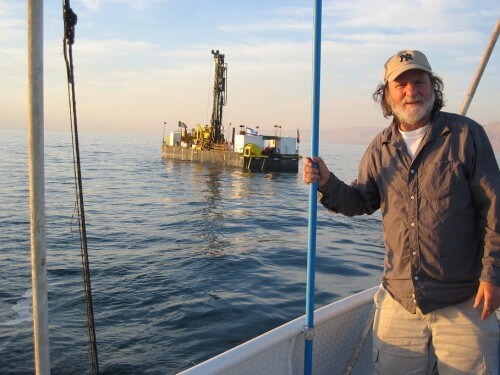An international project of drilling in the Dead Sea, in which researchers from the Freddy and Nadine Herman Institute of Earth Sciences at the Hebrew University participate, opens a window into the climatic and seismic history of the Dead Sea in the last 200,000 years

An international project of drilling in the Dead Sea, in which researchers from the Freddy and Nadine Herman Institute of Earth Sciences at the Hebrew University participate, opens a window into the climatic and seismic history of the Dead Sea in the last 200,000 years. In the project it was found that about 125,000 years ago the sea dried up almost completely as a result of the climate conditions. This finding raises concern about the current state of the Dead Sea, when climate change and human intervention accelerate the drying process.
Dr. Mordechai Stein from the Earth Research Institute at the Hebrew University, one of the researchers working on the drilling project, says: "The Dead Sea is a salty lake located in a deep tectonic depression (the Dead Sea rift) from which the water exits only through evaporation. The Jordan River and the Araba River transport silt and water from the Dead Sea drainage basin to the Dead Sea. The Dead Sea rift area focused the development and activity of man over hundreds of thousands of years and was probably an important route in the migration of prehistoric man on his way out of the African continent. The sedimentary rocks that accumulated during these periods of time under the floor of the modern Dead Sea store information that makes it possible to reconstruct the climate conditions that prevailed in the area of the drainage basin and even in more distant areas such as the Sahara and Arab deserts."
As part of the drilling project, a special rig with drilling equipment suitable for extracting cores of sedimentary rocks from the bottom of lakes was brought to Israel. The drilling itself was carried out between November 2010 and March 2011 at two sites: in the center of the Dead Sea at a water depth of 300 meters and at the edge of the Dead Sea near Ein Gedi beach.
A preliminary analysis of the drilled material shows that the cores produced in the center of the Dead Sea consist of sequences of salts and "muddy" material, indicating very dry and wetter periods respectively in the drainage basin of the Dead Sea. Among the exciting initial discoveries: evidence of the existence of colonies of microorganisms up to a depth of 150 meters below the surface of the ground, as well as a sequence of salts with a total thickness of about 45 meters at a depth of over 200 meters below the surface of the ground and above it a layer of pebbles indicating the presence of a nearby beach. This finding indicates a significant drying of the Dead Sea in the past.
Scientists have shown that the sea will probably stabilize at a depth of about 550 meters below sea level (today it stands at 426 meters below sea level) and will not dry up, but "the evidence of significant natural drying and retreat in the past of the Dead Sea is a warning sign against significant drying in the future. In its natural past, the Dead Sea was restored following the resumption of the hydrological activity of the drainage basin, but such restoration of course requires the restoration of the activity of the natural system of the flow of the Jordan River, which was inhibited as a result of the water consumption of the countries of the region", concludes Dr. Stein.

7 תגובות
Thanks for the update on this interesting topic.
I would be happy to add an update when the tests and revelations continue
1. If the Dead Sea dried up almost completely about 125,000 years ago, does that mean that the level of the Sea of Galilee was also very low at that time?
2. Did the Jordan flow into the Dead Sea at that time?
Dear Abraham,
If the world really worked like that I would believe you, but the truth is that it works exactly the opposite.
Our luck (relatively) is that some of us were not satisfied with the clear and unequivocal truth but asked a lot of questions.
Thanks to this we have an understanding of medicine, agriculture, geology, astronomy, physics and much more... even the website where you search for lost souls...
If you had simply written "I didn't understand" there would have been no need to continue.
The people of Israel are strong and courageous.
The Dead Sea is part of the land promised to the Holy People of Israel, blessed be He.
The drying of the people is a symbol of the measure of keeping the commandments by this holy people.
The stronger the people, the higher the level, and the further away from the Holy One, blessed be He, the lower the level will be until Sodom and Gomorrah are revealed to our eyes and our fate will be like theirs.
Get up and do penance and save your souls.
I didn't understand why we need to be careful about the drying up of the King's Sea. Tectonic activity could have washed away the area. I remember from a popular science lecture about Oholo that the level of the Kinneret was constantly changing and you see there was a continuous human settlement near the Kinneret all this time.